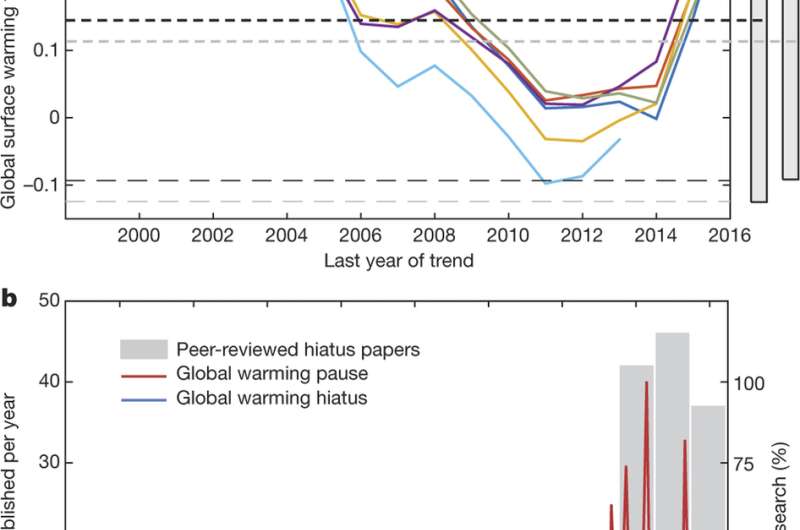May 4, 2017 report
Reconciling differences in interpretations of global warming hiatus

(Phys.org)—A team of researchers with the Institute for Atmospheric and Climate Science has conducted an analysis of the events surrounding the global warming hiatus of 1998 and 2012 and has concluded that inconsistencies reported by scientists can be attributed to natural short-term weather variations, incomplete data and different methods of modeling. In their paper published in the journal Nature, the group contends that the evidence still shows that long-term global warming is and has been occurring for multiple decades and that it will continue to do so in the future. James Risbey and Stephan Lewandowsky with the Oceans and Atmosphere Commonwealth Scientific and Industrial Research Organization and University of Western Australia offer a News & Views take on the work done by the team in the same issue.
By now, it's common knowledge that most scientists believe the planet is slowly growing warmer, and that the warming is due to greenhouse gasses emitted into the atmosphere by human activities. Many have also heard that for the period between approximately 1998 to 2012, there was a "pause" or warming hiatus, which many believed meant that the planet ceased growing warmer for approximately fourteen years. This was not the case, the researchers note; the hiatus was, in fact, a period of time when the planet "appeared" to grow warmer at a slower pace than it had been, and in so doing, defied many models that had been built to predict how fast our planet would heat. In this new effort, the researchers went back and looked at the work done by scientists around the planet regarding global warming and the apparent hiatus. They report that what they found were some minor inconsistencies between calculation methods, changes in monitoring methods, natural weather variations and, perhaps most importantly, that scientists are not nearly as good at predicting short-term global changes as they are at predicting long-term global changes.
The researchers point out short-term monitoring methods can create large differences in results—the conversion from boat-dragged temperature gauges to thermometers tied to buoys, for example, caused ocean readings to drop a little due to the absence of heat generated by the boats dragging the sensors. They also note that the first year of the hiatus followed a record-setting heat wave due to an El Niño event—also, there were wind events during the hiatus that could have carried the heat to places that were not being monitored. It was minor events like these, they suggest, that led to inconsistencies in reporting by scientists working on the problem, and because of that, they should not be interpreted by the media or public as disagreement among scientists regarding the magnitude of the problem. Global warming is happening, they emphasize, and while there might be subtle shifts along the way, there is no evidence that it is slowing.
More information: Iselin Medhaug et al. Reconciling controversies about the 'global warming hiatus', Nature (2017). DOI: 10.1038/nature22315
Abstract
Between about 1998 and 2012, a time that coincided with political negotiations for preventing climate change, the surface of Earth seemed hardly to warm. This phenomenon, often termed the 'global warming hiatus', caused doubt in the public mind about how well anthropogenic climate change and natural variability are understood. Here we show that apparently contradictory conclusions stem from different definitions of 'hiatus' and from different datasets. A combination of changes in forcing, uptake of heat by the oceans, natural variability and incomplete observational coverage reconciles models and data. Combined with stronger recent warming trends in newer datasets, we are now more confident than ever that human influence is dominant in long-term warming.
Journal information: Nature
© 2017 Phys.org


















